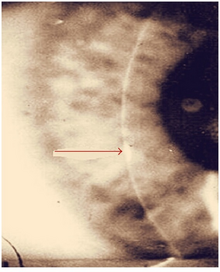Interstitial keratitis
| Interstitial keratitis | |
|---|---|
 | |
| Interstitial keratitis in congenital syphilis | |
| Specialty | Ophthalmology |
Interstitial keratitis (IK) is corneal scarring due to chronic inflammation of the corneal stroma.[1] Interstitial means space between cells i.e. corneal stroma which lies between the epithelium and the endothelium. Keratitis means corneal inflammation.
Signs and symptoms
Acutely, early symptoms include a painful, photophobic, red watery eye. This is due to active corneal inflammation resulting in vascular invasion and stromal necrosis which can be diffuse or localized. This causes the pinkish discoloration of what was a clear transparent normal corneal tissue (called Salmon patch of Hutchinson).[citation needed]
Such vascularization is likely to result in blurring of vision secondary to corneal stromal scarring, the presence of ghost vessels, and thinning of the cornea, especially if it involves the visual axis.[citation needed]
Cause
By far the most common cause of IK is syphilitic disease. However, there are two possible causes of the corneal inflammatory response: an infection and/or an immunological response, such as a hypersensitivity type reaction, or (rarely) Cogan syndrome.[2] Infectious causes include syphilis (commonest), followed by other bacterial infections (TB, Leprosy and Lyme disease) and parasitic infections (Acanthamoeba, Onchocerciasis or river blindness, Leishmaniasis, Trypanosoma cruzi or Chagas disease, Trypanosoma brucei or African sleeping sickness and microsporidia)[3]
Pathophysiology
The corneal scarring is the end result of the initial invasion of blood vessels into the corneal stroma as part of the inflammatory response. Since normal corneal tissue should be avascular (no blood vessel) and therefore clear to allow light to pass, the presence of blood vessel and the infiltration of cells as part of the inflammatory process results in scarring or hazing of the cornea.[4]
Diagnosis

A positive VDRL of Treponema pallidum immobilization test confirms diagnosis of luetic(syphilitic) interstitial keratitis[citation needed]
Treatment
The underlying cause must be treated as soon as possible to stop the disease process. Corticosteroid drop can be used to minimize the scarring on the cornea along with antibiotic cover. However, residual scarring cannot be avoided which can result in long term visual impairment and corneal transplantation is not suitable due to high rejection rate from the corneal vascularization.[5]
History
Previous long-standing eye infection which possibly during childhood time recalled as being treated with antibiotic and/or hospitalized over long period of time.[citation needed]
References
- ↑ Gauthier, A.-S.; Noureddine, S.; Delbosc, B. (June 2019). "Interstitial keratitis diagnosis and treatment". Journal Francais D'ophtalmologie. 42 (6): e229–e237. doi:10.1016/j.jfo.2019.04.001. ISSN 1773-0597. PMID 31103357. Archived from the original on 2022-06-15. Retrieved 2023-05-13.
- ↑ Ramachandran, Tarakad. "Cogan Syndrome". Medlink. MedLink Corporation. Archived from the original on 9 March 2016. Retrieved 11 January 2012.
- ↑ Majmudar PA. "Keratitis, Interstitial" emedicine Dec 2007
- ↑ Dr Khairul Nazri Mohammad (Articles' Author), Waterford General Hospital, IRELAND
- ↑ Kanski JJ. "Clinical Ophthalmology 5th ed"